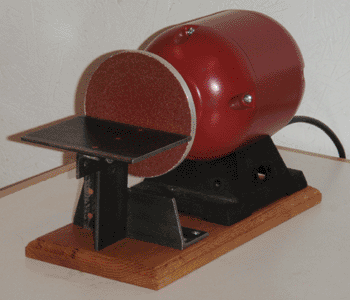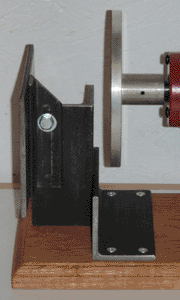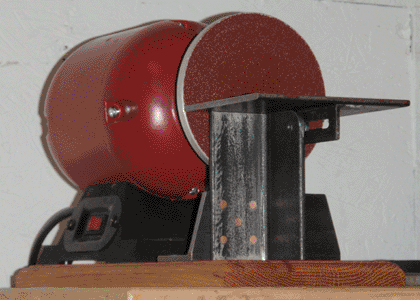


Abrasive tools are necessary for metalworking; harder metals can generally cut softer metals, but the hardest metals must be cut by a different material. Early on, I accomplished this with an ordinary bench grinder; this was adequate for some tasks, but the tool rests were flimsy and small, and the abrasive wheels would quickly lose their shape from wear. Since refining my cutting tools and sharpening methods, I have been able to use a small 1x30 belt grinder instead; this provided a larger tool rest (useful for precise angle setups) but tended to round over cutting edges slightly, even with a rigid platen behind the belt. Furthermore, I found that only high quality belts were suitable for tool grinding, and even these had an unacceptable variance in thickness and length. To resolve all of these issues I built a disc grinder, using the motor of my original bench grinder and various scraps of metal and wood from earlier projects.
The grinder utilizes five-inch adhesive sanding disks, which are common and inexpensive at roughly 20 cents per disk. These adhere to an aluminum platter, which I made from rod and plate joined together with Alumiweld (85% zinc, 15% tin). This platter is attached to the (slightly modified) motor shaft with a roll pin, to allow it to be removed later if necessary. The tool rest support is made of angle iron, and serves to elevate the tool rest to the center of the disk, as well as shield the wooden base from sparks. The rest itself is made of plate steel (scrap from the construction of my aluminum crucible) fixed to its support with a sliding bracket made of angle iron. Both the rest and the support are held together by copper rivets, made by pressing clippings of copper rod into chamfered holes, and then flattening them to fill the chamfers with a ball-peen hammer or a punch. The iron was sanded roughly and wire-brushed to remove any loose scale, then given a protective coat of paste wax, which I have found to be strongly rust-preventative. Finally, the wooden base is made of red oak, with a decorative bead routed around the edge. To render the wood non-absorbent, I gave it a saturating coat of boiled linseed oil; this should protect it from the various fluids involved in metalworking, and limit the discoloration from dust and general handling.
In use, this grinder is far superior to either of its predecessors. The steel table is completely rigid, and the flat grinding surface produces an equally flat surface on the workpiece. A quick test on a lathe bit revealed that not only could it produce a sharp edge, but any burr left from the grinding process could be removed by turning off the grinder and using it as a lapping plate. The tool is fairly quiet, and can be used pleasantly without ear protection. Furthermore, since the plane of the disk is sideways, very little grinding dust is thrown back at the user. Overall, the only improvement I could have made would be to make this tool sooner.